Impact of Land Use and Land Cover Changes on the Stream Flow and Water Quality of Big Creek Lake Watershed South Alabama, USA †
Abstract
:1. Introduction
2. Materials and Methods
2.1. Study Area
2.2. Data Required
2.3. SWAT Model Description
2.4. Uncertainty and Sensitivity Analysis
2.5. SWAT Model Calibration, Validation and Evaluation
3. Results
3.1. Land Use and Land Cover (LULC) Change
3.2. Sensitivity Analysis
3.3. SWAT Model Calibration and Validation
3.4. Stream Flow, Nitrogen, Phosphorus of Different LU Scenarios
4. Discussion
5. Conclusions
Author Contributions
Funding
Institutional Review Board Statement
Informed Consent Statement
Conflicts of Interest
References
- Zhang, M.; Liu, N.; Harper, R.; Li, Q.; Liu, K.; Wei, X.; Ning, D.; Hou, Y.; Liu, S. A global review on hydrological responses to forest change across multiple spatial scales: Importance of scale, climate, forest type and hydrological regime. J. Hydrol. 2017, 546, 44–59. [Google Scholar] [CrossRef] [Green Version]
- Gao, G.; Fu, B.; Wang, S.; Liang, W.; Jiang, X. Determining the hydrological responses to climate variability and land use/cover change in the Loess Plateau with the Budyko framework. Sci. Total Environ. 2016, 557, 331–342. [Google Scholar] [CrossRef] [PubMed]
- Jarsjö, J.; Asokan, S.M.; Prieto, C.; Bring, A.; Destouni, G. Hydrological responses to climate change conditioned by historic alterations of land-use and water-use. Hydrol. Earth Syst. Sci. 2005, 16, 1335–1347. [Google Scholar] [CrossRef] [Green Version]
- Wei, X.; Zhang, M. Quantifying streamflow change caused by forest disturbance at a large spatial scale: A single watershed study. Water Resour. Res. 2010, 46, 1–15. [Google Scholar] [CrossRef]
- Pitman, A.J. The evolution and revolution in land surface schemes designed for climate models. Int. J. Climatol. 2003, 23, 479–510. [Google Scholar] [CrossRef]
- Sy, S.; Noblet-Ducoudré, N.D.; Quesada, B.; Sy, I.; Dieye, A.M.; Gaye, A.T.; Sultan, B. Land-surface characteristics and climate in West Africa: Models’ biases and impacts of historical anthropogenically-induced deforestation. Sustainability 2017, 9, 1917. [Google Scholar] [CrossRef] [Green Version]
- Sertel, E.; Robock, A.; Ormeci, C. Impacts of land cover data quality on regional climate simulations. Int. J. Climatol. 2010, 30, 1942–1953. [Google Scholar] [CrossRef]
- Lee, S.-J.; Berbery, E.H. Land cover change effects on the climate of the La Plata Basin. J. Hydrometeorol. 2012, 13, 84–102. [Google Scholar] [CrossRef]
- Marland, G. The climatic impacts of land surface change and carbon management, and the implications for climate-change mitigation policy. Clim. Policy 2003, 3, 149–157. [Google Scholar] [CrossRef] [Green Version]
- Welde, K.; Gebremariam, B. Effect of land use land cover dynamics on hydrological response of watershed: Case study of Tekeze Dam watershed, northern Ethiopia. Int. Soil Water Conserv. Resour. 2017, 5, 1–16. [Google Scholar] [CrossRef]
- Wang, H.; Sun, F.; Xia, J.; Liu, W. Impact of LUCC on streamflow based on the SWAT model over the Wei River basin on the Loess Plateau in China. Hydrol. Earth Syst. Sci. 2017, 21, 1929–1945. [Google Scholar] [CrossRef] [Green Version]
- Lin, B.; Chen, X.; Yao, H.; Chen, Y.; Liu, M.; Ga, L.; James, A. Analyses of landuse change impacts on catchment runoff using different time indicators based on SWAT model. Ecol. Indic. 2015, 58, 55–63. [Google Scholar] [CrossRef]
- Nie, W.; Yuan, Y.; Kepner, W.; Nash, S.M.; Michael, J.; Caroline, E. Assessing impacts of land use and land cover changes on hydrology for the upper San Pedro watershed. J. Hydrol. 2011, 407, 105–114. [Google Scholar] [CrossRef]
- Gassman, P.W.; Reyes, M.R.; Green, C.H.; Arnold, J.G. SWAT peer-reviewed literature: A review. In Proceedings of the 3rd International SWAT Conference, Zurich, Switzerland, 13–15 July 2005. [Google Scholar]
- Gill, A.C.; McPherson, A.K.; Moreland, R.S. Water Quality and Simulated Effects of Urban Land-Use Change in J.B. Converse Lake Watershed, Mobile County, Alabama, 1990–2003: U.S. Geological Survey Scientific Investigations Report; United States Geological Survey: Reston, VA, USA, 2005; pp. 2005–5171. 110p.
- Mobile Area Water and Sewers Systems (MAWSS). Water System. 2011. Available online: http://www.mawss.com/waterSystem.html (accessed on 31 December 2020).
- Journey, C.A.; Gill, A.C. Assessment of water-quality conditions in the J.B. Converse Lake Watershed, Mobile County, Alabama, 1990–1998. U.S. Geological Survey Water-Resources Investigations Report 01-4225. Available online: http://pubs.er.usgs.gov/publication/wri014225 (accessed on 28 December 2020).
- Monteith, J.L. Evaporation and environment. Symp. Soc. Exp. Biol. 1965, 19, 205–234. [Google Scholar] [PubMed]
- Arnold, J.G.; Kiniry, J.R.; Srinivasan, R.; Williams, J.R.; Haney, E.B. Soil and Water Assessment Tool Input/Output Documentation; TR-439; Texas Water Resources Institute: College Station, TX, USA, 2012; pp. 1–650. [Google Scholar]
- Jacobs, J.H.; Srinivasan, R. Effects of curve number modification on runoff estimation using WSR-88D rainfall data in Texas watersheds. J. Soil Water Conserv. 2005, 60, 274–278. [Google Scholar]
- Jain, M.; Sharma, S.D. Hydrological modeling of Vamshadara River Basin, India using SWAT. In Proceedings of the International Conference on Emerging Trends in Computer and Image Processing (ICETCIP-2014), Pattaya, Thailand, 15–16 December 2014. [Google Scholar]
- Chaubey, I.; Miglizccio, K.W.; Green, C.H.; Arnold, J.G.; Srinivasan, R. Phosphorus Modeling in Soil and Water Assessment Tool (SWAT) Model. In Modeling Phosphorus in the Environment; Radcliffe, D.E., Cabrera, M.L., Eds.; CRC Press: New York, NY, USA, 2007; pp. 163–188. [Google Scholar]
- Abbaspour, K.C.; Yang, J.; Maximov, I.; Siber, R.; Bogner, K.; Mieleitner, J.; Zobrist, J.; Srinivasan, R. Modelling hydrology and water quality in the pre-alpine/alpine Thur watershed using SWAT. J. Hydrol. 2007, 333, 413–430. [Google Scholar] [CrossRef]
- Beven, K.; Binley, A. The future of distributed models: Model calibration and uncertainty prediction. Hydrol. Processes 1992, 6, 279–298. [Google Scholar] [CrossRef]
- Van Griensven, A.; Meixner, T. Methods to quantify and identify the sources of uncertainty for river basin water quality models. Water Sci. Technol. 2006, 53, 51–59. [Google Scholar] [CrossRef]
- Kuczera, G.; Parent, E. Monte Carlo assessment of parameter uncertainty in conceptual catchment models: The Metropolis algorithm. J. Hydrol. 1998, 211, 69–85. [Google Scholar] [CrossRef]
- Marshall, L.; Nott, D.; Sharma, A. A comparative study of Markov chain Monte Carlo methods for conceptual rainfall-runoff modeling. Water Resour. Res. 2004, 40, 1–11. [Google Scholar] [CrossRef]
- Vrugt, J.A.; Gupta, H.V.; Bouten, W.; Sorooshian, S. A shuffled complex evolution Metropolis algorithm for optimization and uncertainty assessment of hydrologic model parameters. Water Resour. Res. 2003, 39, 1–14. [Google Scholar] [CrossRef] [Green Version]
- Refsgaard, J.C. Parameterization, calibration, and validation of distributed hydrological models. J. Hydrol. 1997, 198, 69–97. [Google Scholar] [CrossRef]
- Moriasi, N.; Daniel, G.W.; Pai Naresh, M.; Prasad, D. Hydrologic and water quality models: Performance measures and evaluation criteria. Trans. Soc. Agric. Biol. Eng. (ASABE) 2015, 58, 1763–1785. [Google Scholar] [CrossRef] [Green Version]
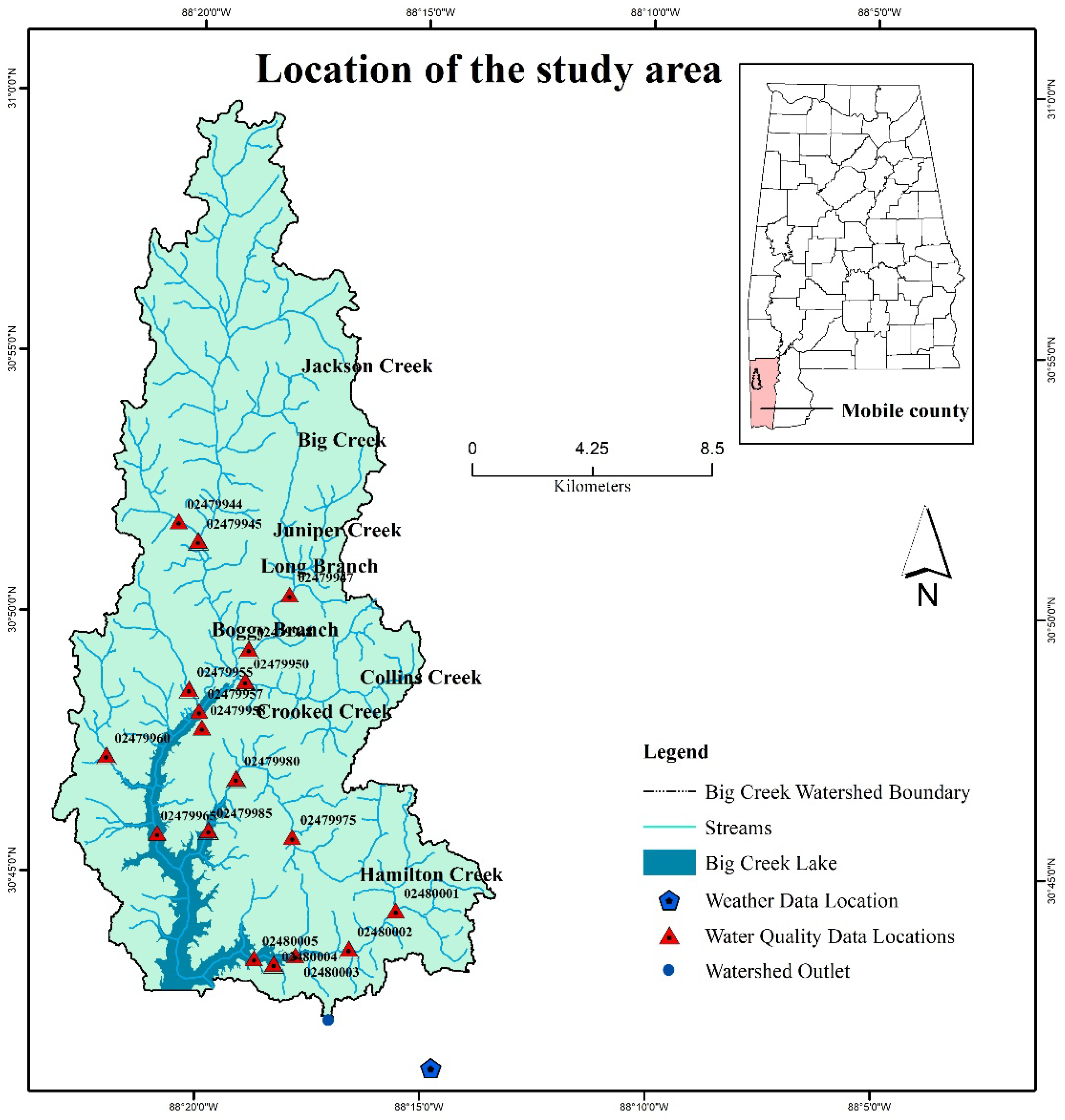
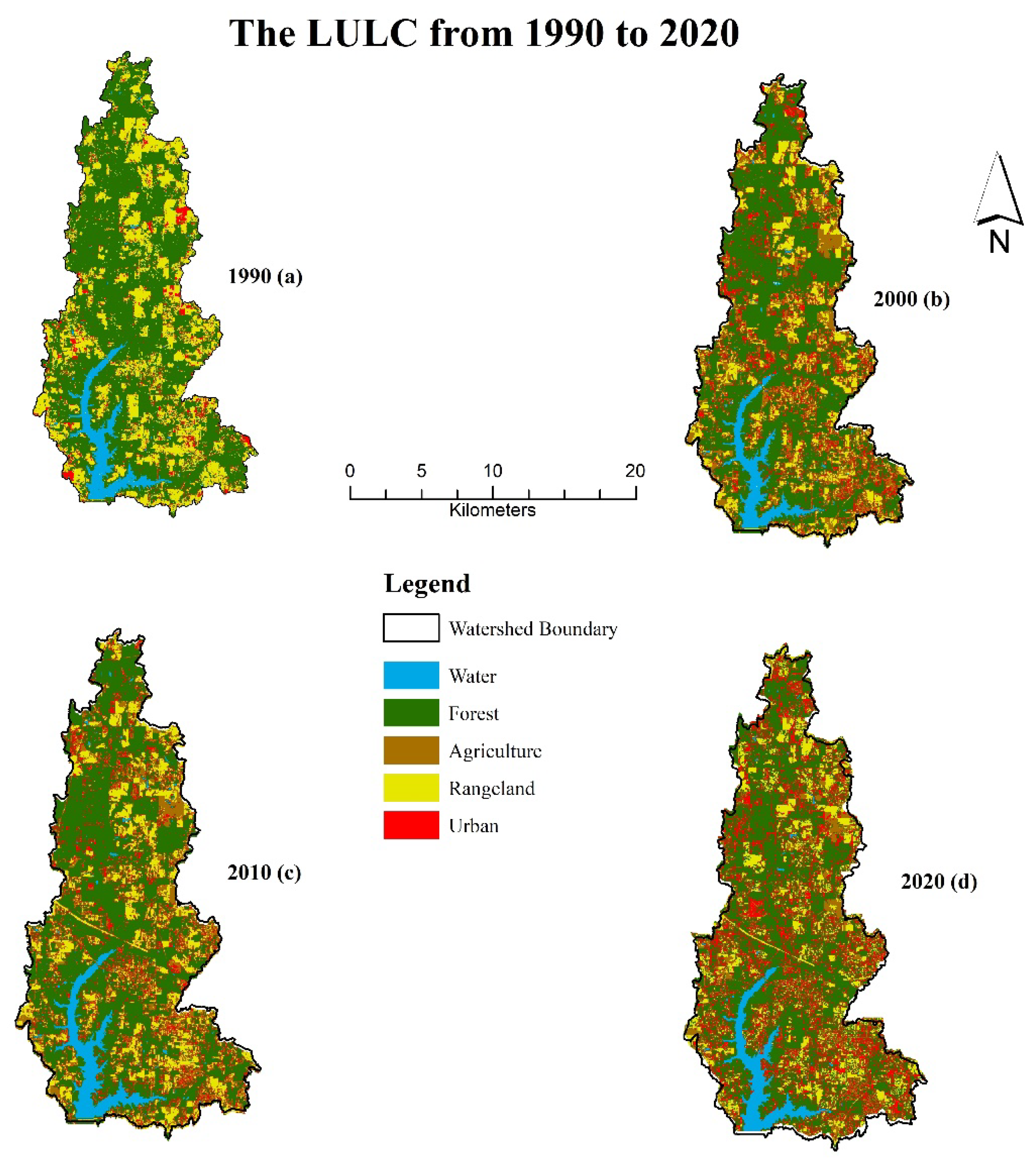
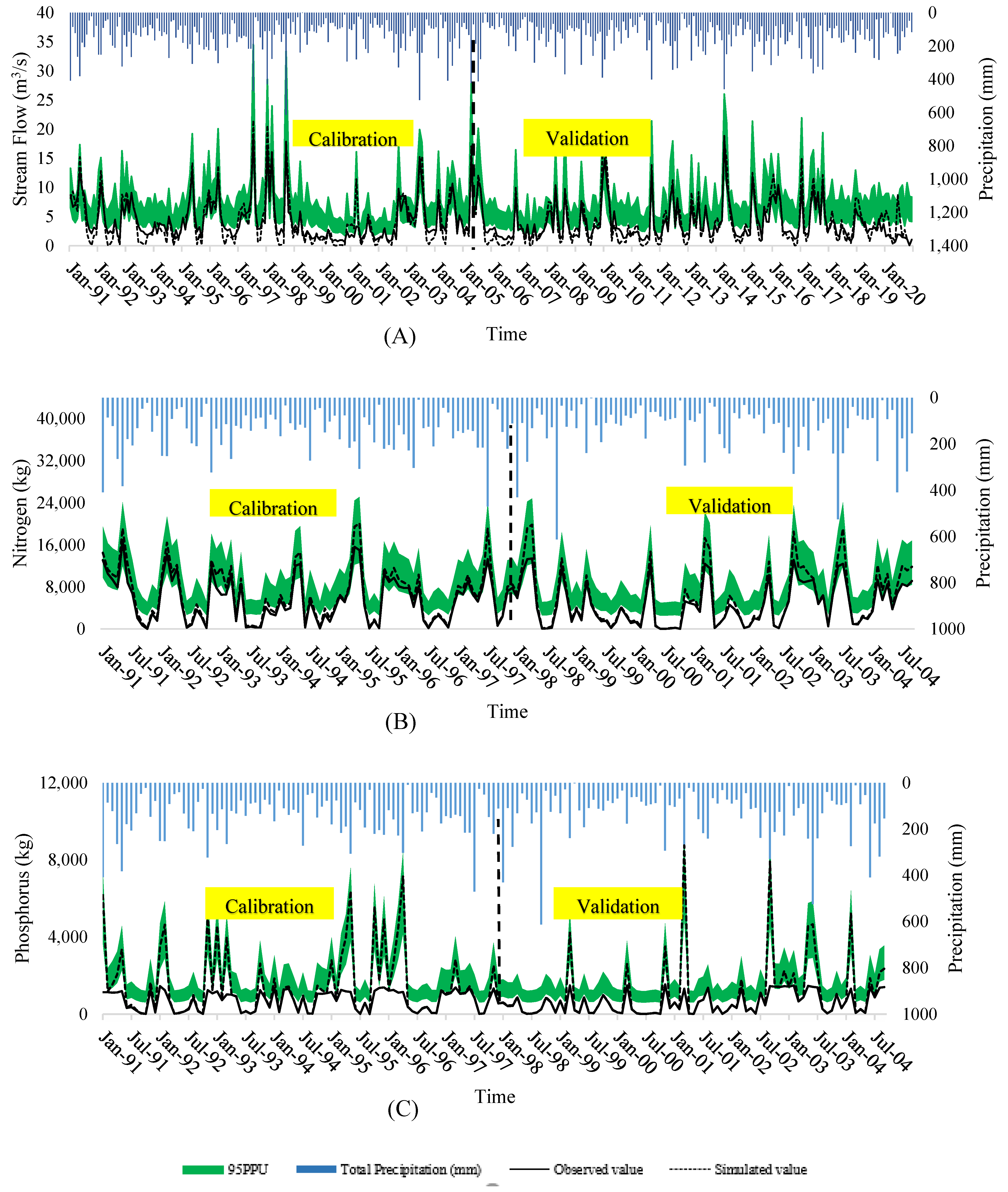
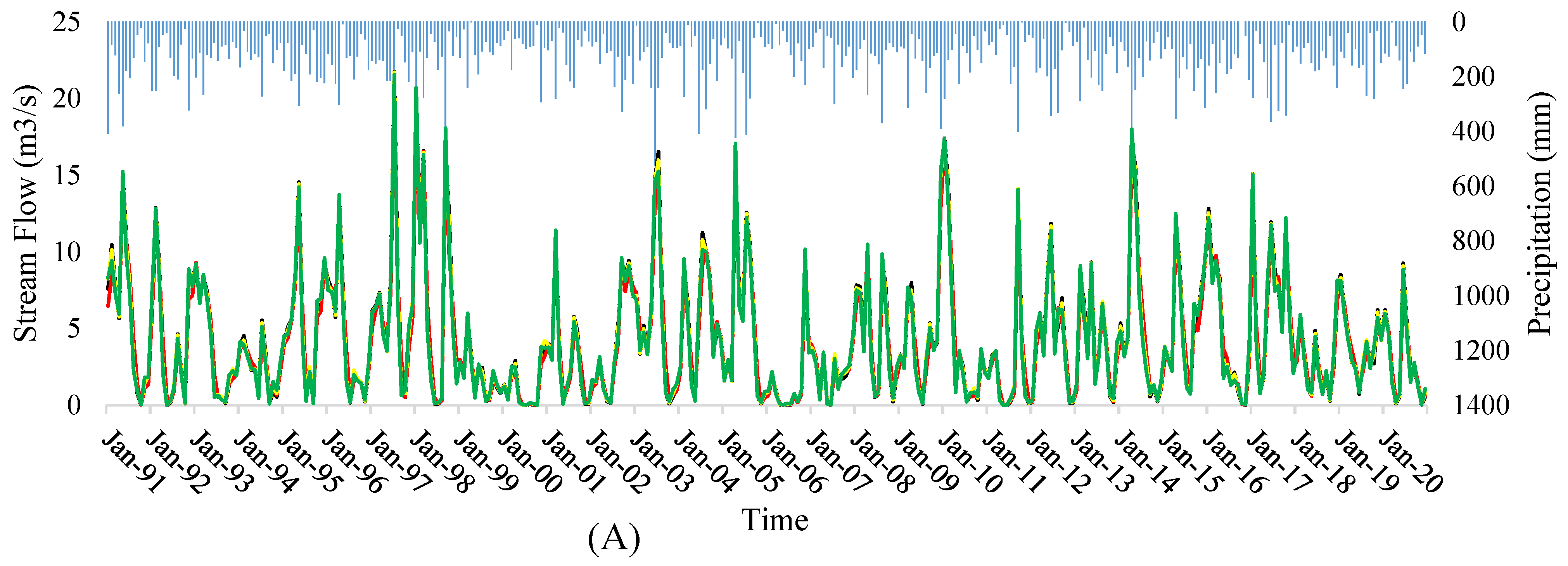
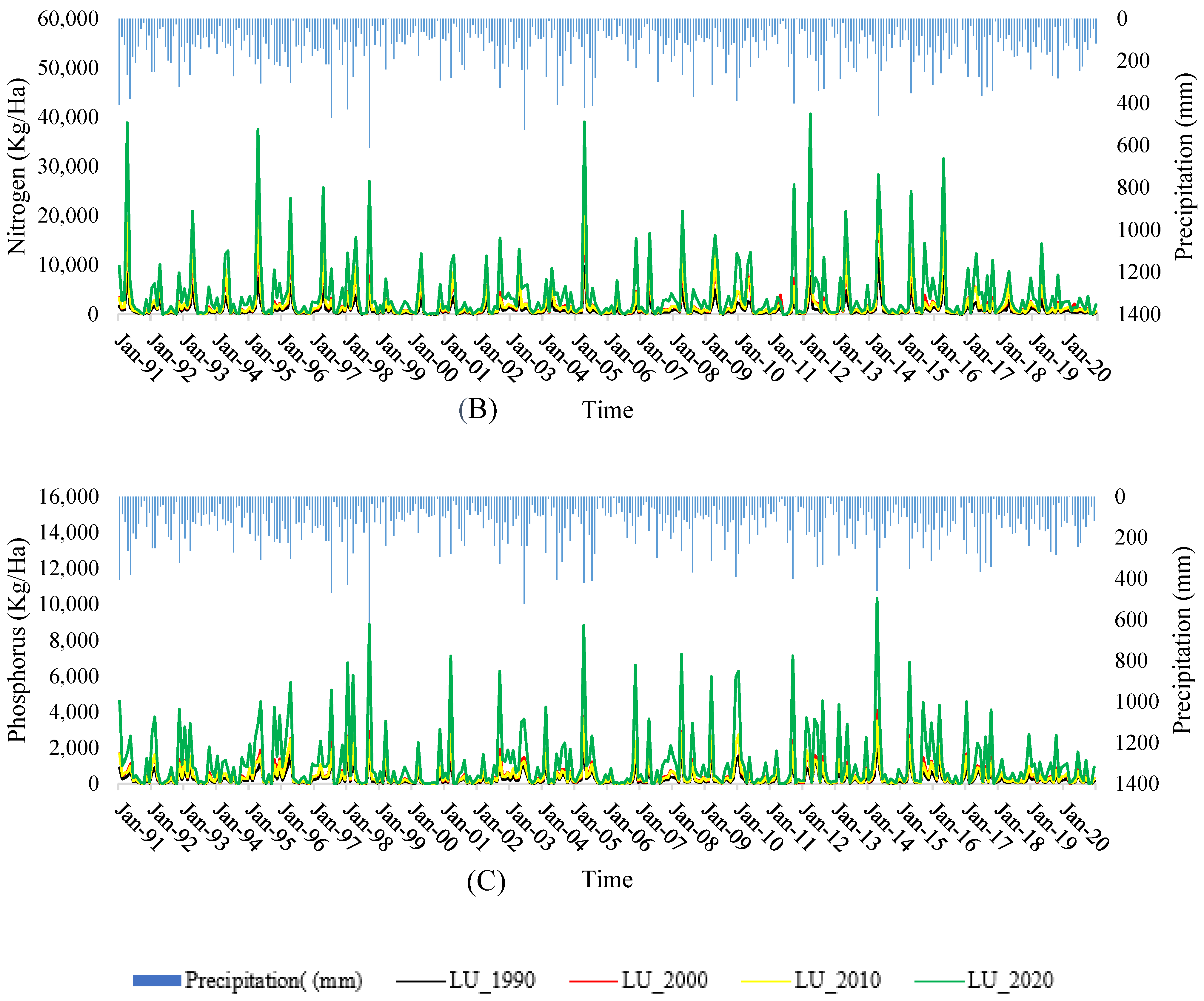
| Parameter | Parameter Description | Fitted Value | Minimum Value | Maximum Value |
|---|---|---|---|---|
| ADJ_PKR | Peak rate adjustment factor for sediment routing in sub watershed | 2 | 0.5 | 2 |
| ALPHA_BF | Baseflow alpha factor (days) | 0.1 | 0 | 1 |
| BIOMIX | Biological mixing efficiency | 0.2 | 0 | 1 |
| CN | Curve number | Decrease 20% | 35 | 98 |
| EPCO | Plant evaporation compensation factor | 0.95 | 0 | 1 |
| ESCO | Soil evaporation compensation factor | 1 | 0 | 1 |
| GW_DELAY | Groundwater delay time (days) | 20 | 0 | 500 |
| GW_REVAP | Groundwater “revap” coefficient | 0.02 | 0.02 | 0.2 |
| OV_N | Manning’s “n” value for overland flow “n” value for overland flow | 1 | 0.01 | 30 |
| PRF | Peak rate adjustment factor for sediment routing in the main channel | 1 | 0 | 1 |
| RCHRG_DP | Deep aquifer percolation factor | 0.05 | 0 | 1 |
| SOL_AWC | Available water capacity of soil layer | 0.7 | 0 | 1 |
| SOL_K | Saturated hydraulic conductivity | 0.2 | 0 | 2000 |
| SPEXP | Exponent parameter for calculating sediment retrained in channel sediment routing | 1.5 | 1 | 1.5 |
| USLE_P | USLE equation support practice factor | 1 | 0 | 1 |
| SOL_LABP | Initial soluble P concentration in sol layer | 0.01 | 0 | 100 |
| SOL_ORGP | Initial organic P concentration in sol layer | 0.01 | 0 | 100 |
| LAT_ORGN | Organic N in the baseflow | 0.01 | 0 | 200 |
| SOL_ORGN | Initial organic N concentration in the soil layer | 0.01 | 0 | 10 |
| Parameter Name | t-Stat | p-Value | Parameter Name | t-Stat | p-Value |
|---|---|---|---|---|---|
| r__ESCO.bsn | −0.215278727 | 0.829640698 | r__EPCO.bsn | 1.115696614 | 0.265105646 |
| r__USLE_P.mgt | −0.226950855 | 0.820557782 | r__CN2.mgt | −1.333777787 | 0.18290399 |
| r__BIOMIX.mgt | 0.227096486 | 0.820444606 | r__ADJ_PKR.bsn | −1.443612737 | 0.149494876 |
| r__ALPHA_BF.gw | −0.278863619 | 0.780468599 | r__PRF_BSN.bsn | −1.948062549 | 0.051985146 |
| r__SOL_K().sol | 0.671455455 | 0.502250766 | r__RCHRG_DP.gw | −1.994993478 | 0.046603828 |
| r__GW_REVAP.gw | −0.728852367 | 0.466444494 | r__OV_N.hru | −2.862365089 | 0.004387183 |
| r__GW_DELAY.gw | 0.846668373 | 0.39759842 | r__SOL_AWC().sol | −38.3178933 | 0 |
| r__SPEXP.bsn | −0.969346487 | 0.332856487 | - | - | - |
| R2 | NSE | PBIAS | ||||
|---|---|---|---|---|---|---|
| Calibration | Validation | Calibration | Validation | Calibration | Validation | |
| Stream Flow | 0.81 | 0.81 | 0.77 | 0.73 | −10.7 | 15.4 |
| Nitrogen | 0.75 | 0.77 | 0.62 | 0.65 | 9.34 | −3.45 |
| Phosphorus | 0.5 | 0.54 | 0.34 | 0.24 | −20.45 | −21.76 |
Publisher’s Note: MDPI stays neutral with regard to jurisdictional claims in published maps and institutional affiliations. |
© 2022 by the authors. Licensee MDPI, Basel, Switzerland. This article is an open access article distributed under the terms and conditions of the Creative Commons Attribution (CC BY) license (https://creativecommons.org/licenses/by/4.0/).
Share and Cite
Eva, E.A.; Marzen, L.J. Impact of Land Use and Land Cover Changes on the Stream Flow and Water Quality of Big Creek Lake Watershed South Alabama, USA. Environ. Sci. Proc. 2022, 15, 9. https://doi.org/10.3390/environsciproc2022015009
Eva EA, Marzen LJ. Impact of Land Use and Land Cover Changes on the Stream Flow and Water Quality of Big Creek Lake Watershed South Alabama, USA. Environmental Sciences Proceedings. 2022; 15(1):9. https://doi.org/10.3390/environsciproc2022015009
Chicago/Turabian StyleEva, Eshita A., and Luke J. Marzen. 2022. "Impact of Land Use and Land Cover Changes on the Stream Flow and Water Quality of Big Creek Lake Watershed South Alabama, USA" Environmental Sciences Proceedings 15, no. 1: 9. https://doi.org/10.3390/environsciproc2022015009
APA StyleEva, E. A., & Marzen, L. J. (2022). Impact of Land Use and Land Cover Changes on the Stream Flow and Water Quality of Big Creek Lake Watershed South Alabama, USA. Environmental Sciences Proceedings, 15(1), 9. https://doi.org/10.3390/environsciproc2022015009






